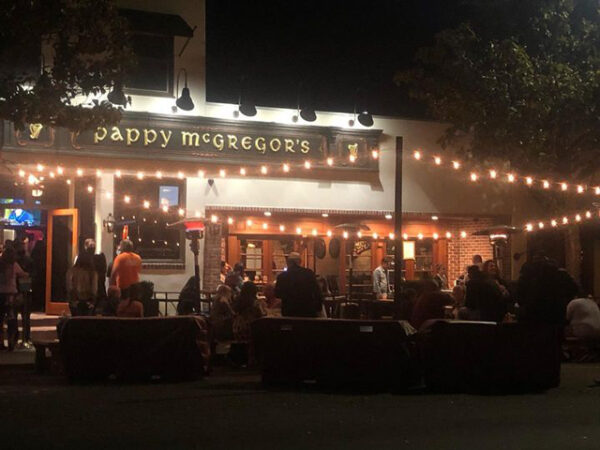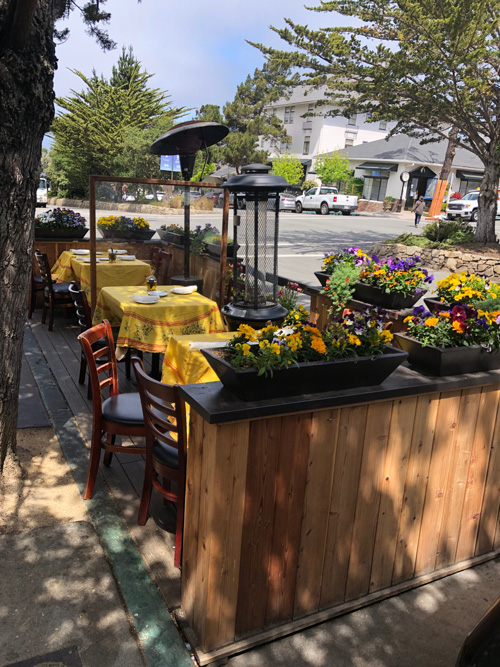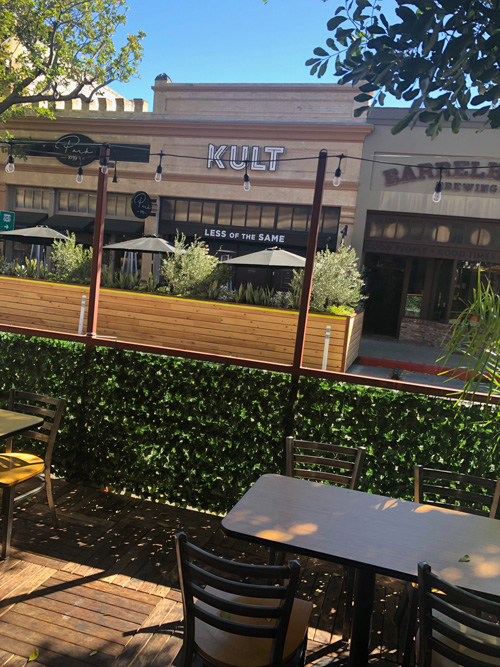Editorial: Thoughtful discussion on the future of parklets

A parklet along Park Street in Paso Robles.
What to do with parklets in Paso Robles?
–On a recent visit to Carmel, I was delighted to see the lovely and inviting parklets that have sprouted across this charming town as residents and businesses struggled to find creative ways to survive the pandemic lockdowns. All across the state and the country, diners and sippers have enjoyed the chance to gather outdoors.
Now that occupancy of restaurants, bars, and tasting rooms is back up to 100% occupancy, it turns out that many, but not all, residents of other communities would like to see some or all of the parklets stick around permanently. Local restaurateurs report that many guests are not yet ready to dine indoors at 100% capacity, and what with concerns about the Delta variant and unvaccinated folks mingling, masked or unmasked, it may be some time before they are.
Pedestrian-only blocks have even sprung up in Ventura and Santa Barbara; in Old-Town Ventura, the closure of Main Street to vehicles is set to become permanent. Entranced by this new “al fresco” vitality, Tiburon and Laguna Beach, among many others, are likely keeping their parklets. Grover Beach is keeping their parklets until at least 2022. In Sonoma County, Healdsburg—with which Paso Robles is often compared because of the downtown park—has extended their parklet permits at least until October 2022, and according to the council, ideally for two additional years. Council staffers have been directed to develop aesthetic guidelines that would kick in after 2022.
“Originally we were looking for a mechanism to help the local businesses, and now we’re looking if it’s something to (permanently) add to the character of the village,” Carmel City Administrator Chip Rerig said.

A parklet in Carmel, Calif.
Carmel and Paso Robles, along with many other communities, are grappling with the big question — to paraphrase The Clash — Should they stay or should they go?
With some exceptions, our Paso parklets have not risen to the aesthetic level I saw in Carmel and also down in San Luis Obispo. Creating a welcoming parklet is not cheap. Plants, shade structures, safety barriers to protect patrons from passing traffic: these can be utilitarian (read: ugly), or attractive ($$$$).
Until cities and towns make a decision on whether to extend the life of their parklets, operators are understandably hesitant to invest. Shelling out multiple tens of thousands of dollars to create a shady and inviting, safe, and user-friendly environment doesn’t make sense if it all must come down on November 1.
One need only take a stroll around any European city to see the warmth and camaraderie that comes with outdoor dining, coffee- and tea-quaffing, and wine tasting.
In Paso Robles, the conversation continues. At the March 16 city council meeting, Gina Fitzpatrick announced that the extensive survey taken by the Paso Robles Chamber of Commerce, which went out to local community members as well as local businesses, returned a 79% “keep the parklets result,” but the survey has not yet been released to the public. (The chamber of commerce did not respond to my request for a comment.) It is hoped that the question will again be addressed at the city council meeting in August, but that can only happen if it’s actually placed on the agenda.

A parklet in downtown San Luis Obispo.
In many spots around the country and the world, café culture doesn’t last past the onset of cool weather, but in California, we are blessed with a Mediterranean climate, and embracing cafe culture seems like a no-brainer. However, unlike New Yorkers, many Californians don’t understand the joys of strolling and window-shopping. Instead of parking a stone’s throw from their destination, ambling from a parking spot to a restaurant encourages locals and visitors to explore side streets (and businesses) they might have sped right by.
But what about the loss of parking? There is actually ample — but little-known — parking within a block or two of most downtown businesses. Behind the library/city hall/courthouse, for instance, is usually wide open in the evening, as is the lot just west of Siegel’s Jewelry (available to the public after 8 p.m.), and the ex-Couch Potato lot. With 100% indoor capacity restored, some businesses could “give back” one or more parking spots in the interest of community spirit.
What about close-in spaces — will those with limited mobility get shut out? Recently the city has lowered senior parking passes to $5/month; what about setting aside a percentage of spaces as disabled-only? Perhaps businesses that will profit from increased revenue because of the parklets could help fund a valet service. The city could help, utilizing the relative tsunami of extra tax dollars that would come with that increased revenue. Other suggestions across social media: Bicycle rickshaws to shuttle folks in from more remote parking; turning the park into a one-way system. There are so many great ideas out there!

Columnist Brigit Binns.
Emergency vehicle access? Fire Marshall Randy Harris tells me that he has no problem with the parklets. “Whether it’s a car or a couple of tables, we still have to maneuver around it. Every 75 feet we maintain an access point.”
Safe access for handicapped persons? Certainly, sidewalks must be kept clear of waiting patrons and bus stations, so that wheelchairs can easily navigate. Drop-off zones would benefit those with mobility issues and those who don’t feel like walking a couple of extra blocks. An Uber code with a 10% discount within city limits is another possibility.
How can we ensure that all parklets complement the look and feel of our unique community? What’s to stop those ugly orange safety barriers (aka K-rails) from proliferating? Like many communities, Paso would need to adopt design and materials guidelines and even requirements, which would have to be set by the city. In the same way, any outdoor business space must be approved and permitted, parklets would need to toe the line.
My take-away from all the conversations is that what you see now is not at all what you’d see if the parklets were extended. If restaurant and tasting room owners know the parklets will stay, they will be more than happy to fix them up. And landlords may benefit from increased property values.
On Nextdoor, a lively discussion has emerged, and a petition to get rid of the parklets as of Oct. 31 is being circulated by one resident. A majority of commenters seem to love the idea of the parklets, even while many find their current iterations to be “ugly.” A vocal minority remains opposed, across the board.
Here are some off-the-cuff opinions gleaned, when reaching out to various members of the community
Norma Moye, Downtown Main Street Association: “Our board has not taken a position yet, and I speak for all of downtown. But, our survey results are as follows: 30% support the parklet program to expire on Oct. 31; 15% support extending the temporary parklet program, and 55% support development of a permanent program with design standards and a fee structure.”
Joel Peterson, Executive Director, Paso Robles Wine Country Alliance: “We at the Wine Alliance understand and recognize the issue from multiple points of view. There’s a lot to consider in how the parklet program affects our downtown, including equity of stakeholders, guidelines on appearance, and how we keep the charm of downtown for visitors and locals alike. We look forward to the conversation.”
Stacie Jacob, Executive Director of Travel Paso: “During the pandemic, our focus was on supporting our local ecosystem; we saw restaurants as very vulnerable, and we spearheaded Dining in the Park. After briefly re-opening, everything shut down again on July 13 and the parklets became a lifeline to survival—everyone wanted to be sure there would be something to come back to when all of this was eventually over. The City moved within a week to approve and implement the parklets; there wasn’t much time to specify aesthetics or materials. What seems clear now is that a lot of people are not ready to sit right next to each other, so the parklets give them room to spread out. Yes, we will definitely need design standards and a fee structure to provide an equitable balance to serve the needs of the community, businesses, and customers.”
Thomas Humphrey, owner and CEO of soon-to-launch Paso Robles Valet and Transportation: “Parking is and has been an ongoing issue in downtown Paso Robles, and I’ve attended many city council meetings to try to assist with a solution. Paso Robles Valet and Transportation is one of the many solutions that would assist with the lack of parking downtown. Paso Robles Valet company will be launching in the very near future, with the assistance of the city. This will give residents, employees, and visitors an opportunity to drop off and pick up their vehicle in a convenient centralized downtown location.“
Andrea DeWit and Beatrice Asseo, co-owners of AndBe Boutique, in between Alchemist’s Garden and Studios on The Park in Paso Robles: “It’s really nice to sit outdoors in the evenings, and it gives the town a really lively feel. We think it definitely brings more tourists to our downtown, so it’s good for our business.”
Carol Hoyt, owner of Hoyt Family Vineyards tasting room on Park Street between 14th and 15th Street: “I love the parklets—it saved our business during the pandemic—but closing off a street or part of a street as they have done in Ventura and Santa Barbara would be even better. It feels very European. If there is some positive takeaway from this pandemic, these are the ones for me: working remotely; dining outside; food to go, cocktails to go. People tended to stay in that downtown block, but now that there is more outdoor action, people are expanding their journey beyond the square. People out walking see the action and want to be a part of it. We’d be willing to invest in our parklet in line with our brand, if we knew it was going to stay. Yes of course, we’d abide by any design and materials guidelines the city might implement.”
Camilla Svensson Burns, owner of retail shop Bijou, on 12th Street between Park and Spring: “I love them! I see no evidence that the parklets have hurt my business. I think people window-shop in the evening and then come back the next day to really shop. I have spent a lot of time in Europe, and the outdoor dining reminds me of that warm sensibility. But now that 100% indoor occupancy is back, I’d like to see some of the larger parklets cut down, perhaps by half. That’s a nice compromise and returns some of the parking spots. ”
Carole MacDonal, owner of Il Cortile and La Cosecha Restaurants: “Our customers overwhelmingly love our parklet! It’s hard for me to believe that the City would ignore the potential revenue that extending the parklets would offer.”
Let the conversations continue! It seems that necessity truly is the mother of invention.





















